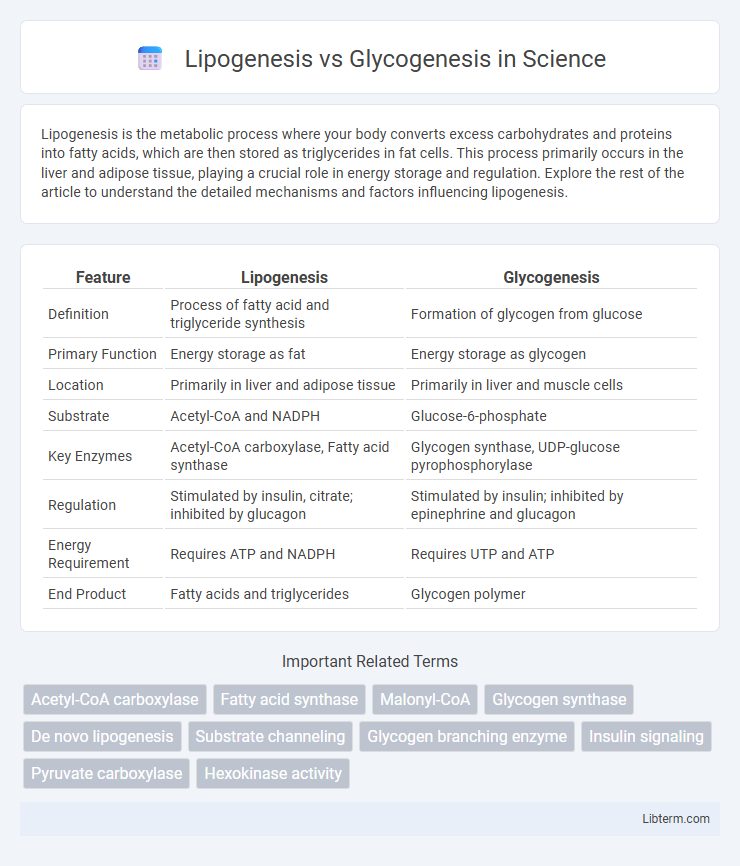Lipogenesis is the metabolic process where your body converts excess carbohydrates and proteins into fatty acids, which are then stored as triglycerides in fat cells. This process primarily occurs in the liver and adipose tissue, playing a crucial role in energy storage and regulation. Explore the rest of the article to understand the detailed mechanisms and factors influencing lipogenesis.
Table of Comparison
| Feature | Lipogenesis | Glycogenesis |
|---|---|---|
| Definition | Process of fatty acid and triglyceride synthesis | Formation of glycogen from glucose |
| Primary Function | Energy storage as fat | Energy storage as glycogen |
| Location | Primarily in liver and adipose tissue | Primarily in liver and muscle cells |
| Substrate | Acetyl-CoA and NADPH | Glucose-6-phosphate |
| Key Enzymes | Acetyl-CoA carboxylase, Fatty acid synthase | Glycogen synthase, UDP-glucose pyrophosphorylase |
| Regulation | Stimulated by insulin, citrate; inhibited by glucagon | Stimulated by insulin; inhibited by epinephrine and glucagon |
| Energy Requirement | Requires ATP and NADPH | Requires UTP and ATP |
| End Product | Fatty acids and triglycerides | Glycogen polymer |
Introduction to Lipogenesis and Glycogenesis
Lipogenesis is the metabolic process that converts excess acetyl-CoA into fatty acids for energy storage, primarily occurring in the liver and adipose tissue. Glycogenesis involves the synthesis of glycogen from glucose molecules, serving as a critical mechanism for maintaining blood glucose levels and energy reserves in muscle and liver cells. Both pathways are essential for cellular energy homeostasis, with lipogenesis storing energy as fat and glycogenesis storing energy as glycogen.
Key Definitions and Biological Relevance
Lipogenesis is the metabolic process of synthesizing fatty acids from acetyl-CoA, primarily occurring in the liver and adipose tissue, crucial for energy storage in the form of triglycerides. Glycogenesis involves the conversion of glucose molecules into glycogen, a polysaccharide stored in liver and muscle cells, serving as a vital short-term energy reserve. Both processes regulate energy homeostasis by storing excess nutrients, with lipogenesis managing long-term fat storage and glycogenesis providing rapid glucose availability.
Overview of Metabolic Pathways
Lipogenesis is the metabolic pathway that converts acetyl-CoA into fatty acids, primarily occurring in the liver and adipose tissue, playing a crucial role in energy storage as triglycerides. Glycogenesis involves the conversion of glucose molecules into glycogen, primarily in the liver and muscle cells, serving as a rapid-release energy reserve. Both pathways are regulated by hormonal signals such as insulin, with lipogenesis focusing on lipid biosynthesis and glycogenesis on carbohydrate storage.
Enzymatic Processes Involved
Lipogenesis primarily involves enzymes like acetyl-CoA carboxylase and fatty acid synthase, which catalyze the conversion of acetyl-CoA to fatty acids. Glycogenesis is driven by glycogen synthase, enabling the polymerization of glucose units into glycogen, with branching enzyme facilitating branch formation. Both processes are regulated by hormonal signals that modify enzyme activity to balance energy storage.
Regulatory Mechanisms
Lipogenesis is primarily regulated by insulin and the activation of acetyl-CoA carboxylase, which catalyzes the conversion of acetyl-CoA to malonyl-CoA, while glycogenesis is controlled by glycogen synthase activity modulated by insulin and glucose-6-phosphate. AMP-activated protein kinase (AMPK) inhibits lipogenesis by phosphorylating acetyl-CoA carboxylase, reducing fatty acid synthesis, whereas glycogen phosphorylase kinase regulates glycogen breakdown opposing glycogenesis. Hormonal signals such as glucagon and epinephrine suppress glycogenesis by activating protein kinase A, which phosphorylates and inactivates glycogen synthase.
Physiological Roles in Energy Storage
Lipogenesis primarily converts excess glucose into fatty acids and triglycerides, serving as a long-term energy storage mechanism in adipose tissue. Glycogenesis synthesizes glycogen from glucose, providing a readily mobilizable energy reserve in liver and muscle cells for short-term energy demands. Both pathways regulate energy homeostasis by balancing immediate fuel needs and prolonged energy storage.
Differences in Substrate and End Products
Lipogenesis primarily utilizes acetyl-CoA derived from excess glucose or fatty acids to synthesize fatty acids, whereas glycogenesis uses glucose molecules to form glycogen for energy storage. The end product of lipogenesis is triglycerides stored in adipose tissue, while glycogenesis results in the formation of glycogen stored mainly in liver and muscle cells. These pathways differ significantly in substrate specificity and the type of macromolecule produced for energy reserve purposes.
Hormonal Control and Signaling Pathways
Insulin plays a central role in stimulating both lipogenesis and glycogenesis by activating key enzymes like acetyl-CoA carboxylase for fatty acid synthesis and glycogen synthase for glycogen formation through the Akt signaling pathway. Glucagon and epinephrine inhibit these anabolic processes by increasing cyclic AMP levels, activating protein kinase A, which phosphorylates and inactivates enzymes involved in lipogenesis and glycogenesis. The balance between these hormonal signals tightly regulates energy storage, ensuring metabolic flexibility in response to nutritional and physiological states.
Clinical Implications and Disorders
Lipogenesis and glycogenesis are critical metabolic pathways influencing energy storage, with disruptions linked to clinical disorders such as obesity, type 2 diabetes, and non-alcoholic fatty liver disease (NAFLD). Excess lipogenesis can lead to abnormal fat accumulation, contributing to insulin resistance and metabolic syndrome, while impaired glycogenesis affects glucose homeostasis and can precipitate conditions like glycogen storage diseases and hypoglycemia. Understanding the balance between these pathways is vital for developing targeted therapies in metabolic and endocrine disorders.
Conclusion: Comparative Summary and Significance
Lipogenesis converts excess glucose into fatty acids for long-term energy storage, while glycogenesis transforms glucose into glycogen for short-term reserve in liver and muscles. Both processes regulate energy homeostasis but differ in speed and storage capacity, with glycogenesis providing rapid energy release and lipogenesis supporting prolonged energy needs. Understanding their balance is crucial for metabolic health and managing disorders like diabetes and obesity.
Lipogenesis Infographic

 libterm.com
libterm.com